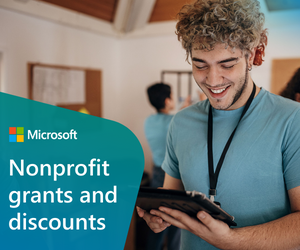3 Tips for Building Community Through Your Nonprofit's Brand

It’s no secret that community support allows your nonprofit to thrive. If your organization engages its supporters effectively, they’ll provide reliable funding and help further your mission for years to come. More than that, they’ll feel like part of a movement to create lasting, positive change where they live.
One often overlooked tool for community-building is your nonprofit’s brand. Although you aren’t selling a product or service to customers—the main purpose of for-profit companies’ brands—branding is still essential for your organization. It encourages supporters to come together around your mission and donate or get involved.
In this guide, we’ll walk through three helpful tips to build community through your nonprofit’s brand, including how to:
- Design a Memorable Logo
- Craft Mission-Centered Messages
- Brand Consistently Across Marketing Channels
As you incorporate these ideas into your strategy, remember that the purpose of branding is to make your nonprofit recognizable. The confidence your audience feels when they can immediately identify a message from your organization and know that their response will help you make a difference is vital for developing a strong community of support for your mission. Let’s get started!
1. Design a Memorable Logo
According to Loop, a nonprofit logo is “the visual representation of your organization’s identity. It translates your mission, vision, and values into a graphic that encapsulates who you are [and] what you stand for.” This is why logos are likely the first thing that comes to mind when you and your supporters think of brands—consider the Nike “swoosh” or the WWF panda, for example.
To create a memorable logo for your organization, try these strategies:
- Choose colours carefully. Color psychology applies heavily to logo design, as certain colors are associated with ideas and emotions that your audience will ascribe to your nonprofit. For example, many healthcare organizations include red in their logo designs to evoke urgency and boldness, while green is a favourite logo color of environmental nonprofits because it’s associated with nature and growth.
- Keep your logo simple, but make sure it stands out. Simpler logo designs are easier for supporters to recall, so limit your color palette and avoid making the logo’s main symbol overly intricate. However, try to balance simplicity with uniqueness—make sure your logo is different enough from similar organizations’ that community members won’t confuse them.
- Create several versions of your logo. Every marketing material you create will have a different amount of available space to fit your logo. Once you’ve chosen a primary logo design, create a few variations of it so you have an option that works for any piece of content. For example, you could use the full-color version of your logo in digital content but also create a black-and-white variant that is easier to print for direct mail.
When supporters repeatedly see your logo together with the rest of your nonprofit’s brand, it will help increase awareness of your mission in your community. Plus, your logo functions as a seal of approval to foster trust in your organization.
2. Craft Mission-Centered Messages
Although visuals are the most common elements associated with branding, your nonprofit’s brand also extends to messaging. The way your organization talks about itself and its mission influences supporters’ opinions of you and is a deciding factor in whether they’ll come together around your cause.
The main aspects of brand messaging that you should define for your nonprofit include:
- Word choice. Decide what words and phrases you want (and don’t want) to use when describing your mission and work. For example, does your nonprofit “help” people or “partner with” them?
- Tone. Make sure the way you characterize your organization is evident in written content. Is your nonprofit optimistic, compassionate, driven, or a different adjective?
- Stylistic conventions. Your organization’s written messages should also follow the same rules of mechanics. For instance, does your organization always use the Oxford comma or only include it when absolutely necessary?
Additionally, remember to center your nonprofit’s cause in every message. Always reference your mission statement and organizational values as you write, and leverage storytelling techniques, images, and collected data to demonstrate why your work is vital to your community.
3. Brand Consistently Across Marketing Channels
Multi-channel marketing strategies are highly effective for nonprofits, since the more touchpoints community members have with your organization, the more likely they are to get involved. To ensure your brand remains recognizable regardless of the channel it’s on, keep all of your materials consistent in their visuals and messaging.
In particular, pay special attention to these popular nonprofit marketing channels:
- Your website: The best nonprofit websites function as information hubs and tools that facilitate engagement. Educate visitors about your mission by applying your messaging standards to every page. Then, use color and cause-centered imagery to inspire support.
- Email marketing: Include branded letterheads on your newsletters and email fundraising appeals so audiences see your organization’s logo and colors right away. Additionally, have staff members incorporate your logo into their email signatures to inspire confidence when supporters receive messages from them.
- Social media: Set your logo as your nonprofit’s profile picture on each social media platform you use (most organizations today are on Facebook, Instagram, and LinkedIn at minimum) so it’s visible with every post. Then, incorporate your brand colors, typography, imagery, and messaging into every post.
- Print communications: Although many nonprofits focus on digital marketing, print materials can supplement your online efforts and expand your reach in your local community. Create branded letterheads for direct mail messages (similar to the ones in your emails) and design eye-catching flyers to advertise in your community.
Incorporate branding into non-traditional advertising as well. For example, if your nonprofit hosts an in-person fundraising event like an auction or 5K race, add your logo to your event signage and decorate your venue in your brand colors. Or, you could design branded merchandise so supporters can spread awareness of your organization every time they wear a t-shirt or drink from a water bottle with your logo on it.
________________________________________________________________________________________________________________
Your nonprofit’s brand is a powerful tool to build recognition and trust with supporters. After all, they'll be more likely to engage with your organization if they can easily identify it and trust that their contributions will make a tangible, lasting impact. More than that, your supporters can then come together around your cause, strengthening the community that your nonprofit relies on to further its mission.




